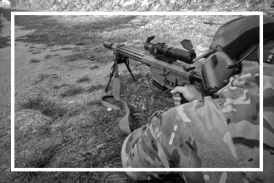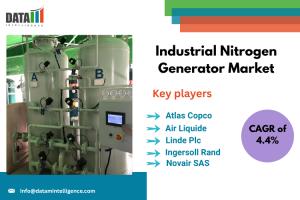Industrial Nitrogen Generator Market Grows with PSA & Membrane Tech for Food,Pharma & Oil Industries| DataM Intelligence
Explore how industrial nitrogen generators are transforming energy efficiency &reliability across food,pharma, oil & gas and electronics manufacturing globally.
Get Latest Sample Report Pdf : https://datamintelligence.com/download-sample/industrial-nitrogen-generator-market
Market Drivers are :
Rising demand in food & beverage packaging: Nitrogen is widely used for food preservation through modified atmosphere packaging (MAP), extending shelf life and maintaining product quality.
Growth in pharmaceutical and chemical industries: High-purity nitrogen is essential for inerting, blanketing, and purging applications to avoid contamination and oxidation.
Cost-efficiency over bulk delivery: On-site nitrogen generation eliminates logistics, storage, and recurring refill costs, especially beneficial for remote industrial facilities.
Increased adoption in oil & gas and petrochemicals: Nitrogen is vital in drilling, enhanced oil recovery, and pipeline purging due to its inert characteristics.
Technological advancements in PSA and membrane systems: New-generation Pressure Swing Adsorption (PSA) and membrane-based systems offer higher purity levels and lower energy consumption.
Stringent safety regulations: On-site generation reduces the hazards associated with high-pressure gas cylinders and improves workplace safety compliance.
Rising environmental awareness: Reducing transportation emissions and gas losses through on-site production contributes to lower carbon footprints.
Key Players in the Industrial Nitrogen Generator market are :
The global market is highly competitive, with key players focusing on product innovation, regional expansion, and industry-specific solutions. Major companies include:
Hitachi Industrial Equipment System Company
Inmatec
Parker Hannifin Corporation
Ingersoll Rand
Air Products and Chemicals, Inc.
Atlas Copco
Air Liquide
Linde Plc
Novair SAS
Oxymat A/S
These manufacturers are known for their broad product portfolios, advanced system design, and ability to customize solutions for diverse industrial needs.
Market Segmentation
By Technology
Pressure Swing Adsorption (PSA) – High purity, ideal for critical applications.
Membrane Separation – Lower purity, energy-efficient for less stringent needs.
Cryogenic Distillation – Large-scale, ultra-high purity systems.
By End-Use Industry
Food & Beverage – Packaging, storage, and bottling.
Pharmaceuticals – Inerting, cleanroom atmosphere, product blanketing.
Chemicals & Petrochemicals – Flammable material handling and oxidation prevention.
Electronics & Semiconductors – Purging, soldering, and wafer manufacturing.
Metal Manufacturing & Fabrication – Laser cutting, welding, and annealing processes.
Oil & Gas – Pressure testing, enhanced oil recovery, and pipeline inerting.
By Region
North America – Strong demand in oil & gas and industrial manufacturing.
Europe – Driven by green energy policies and pharmaceutical production.
Asia-Pacific – Fast-growing chemical and electronics sectors, especially in China and India.
Latin America & MEA – Expanding oil & gas infrastructure and food packaging industries.
Latest News – USA
In 2024, Parker Hannifin Corporation launched its next-generation PSA nitrogen generator for small-scale pharmaceutical and food production units. The system boasts energy savings of over 20% and remote diagnostics via IoT-enabled sensors. Additionally, Ingersoll Rand announced a strategic partnership with a major U.S. brewery to supply modular nitrogen systems tailored to high-volume bottling operations.
Latest News – Japan
In Japan, Hitachi Industrial Equipment System Company expanded its manufacturing facility in Yokohama to meet growing domestic demand for compact membrane nitrogen generators used in semiconductor fabrication. Meanwhile, Air Liquide Japan collaborated with a local logistics firm to integrate nitrogen-based fire suppression systems in their automated warehouses, enhancing safety standards.
Recent Key Developments are :
Atlas Copco introduced an advanced nitrogen generator series for laser cutting operations with integrated oxygen monitors for real-time purity control.
Inmatec released a mobile nitrogen generation unit for offshore drilling platforms, catering to dynamic environments and space constraints.
Linde Plc enhanced its digital service platform, offering predictive maintenance and system optimization tools for industrial nitrogen generators.
Novair SAS developed an energy-efficient PSA system that uses eco-friendly materials and recyclable components, targeting European sustainability goals.
Oxymat A/S expanded into the Southeast Asian market by establishing a service hub in Singapore, supporting regional industrial clients.
These developments reflect the market’s move toward high-efficiency, modular, and digitally integrated systems that align with modern industrial automation trends.
Conclusion
The Industrial Nitrogen Generator Market is steadily advancing, propelled by the shift toward self-sufficient and cost-effective industrial gas systems. With growing application across diverse industries and increasing demand for uninterrupted nitrogen supply, especially in remote and high-demand environments, the market is set for sustained growth through 2030. As end-users seek more control, lower operational costs, and enhanced safety, nitrogen generator manufacturers continue to innovate through advanced technologies and sustainable designs. The market’s steady CAGR of 4.4% is a reflection of the crucial role nitrogen generators play in supporting global industrial operations in a post-pandemic, efficiency-driven era.
Purchase Your Subscription to Power Your Strategy with Precision: https://www.datamintelligence.com/reports-subscription
Browse for more reports:
Industrial Water Treatment Market
Unmanned Surface Vehicle (USV) Market
Sai Kumar
DataM Intelligence 4market Research LLP
+1 877-441-4866
email us here
Visit us on social media:
LinkedIn
X
Legal Disclaimer:
EIN Presswire provides this news content "as is" without warranty of any kind. We do not accept any responsibility or liability for the accuracy, content, images, videos, licenses, completeness, legality, or reliability of the information contained in this article. If you have any complaints or copyright issues related to this article, kindly contact the author above.
Animal Milk Replacer Market Expected to Hit $8.5 Billion by 2035, Registers Steady 5.3% CAGR
Dog Supplement Market 2025 is Projected to Grow Expeditiously: USD 468.5 Million Revenue by 2031, Claims AMR
Adelaide Arborist Highlight the Importance of Qualified Tree Management
Więcej ważnych informacji
 Jedynka Newserii
Jedynka Newserii

 Jedynka Newserii
Jedynka Newserii

Polityka

Unijne mechanizmy ułatwiają zwiększenie wydatków na obronność przez europejskie kraje NATO. Ważnym aspektem infrastruktura podwójnego zastosowania
Wydatki na obronność w krajach NATO mają wzrosnąć do 2035 roku do 5 proc. PKB. W dużej mierze będzie to możliwe dzięki Unii Europejskiej, która stworzyła ramy umożliwiające krajom członkowskim realizację celów NATO w zakresie obronności, nie tylko poprzez finansowanie i inwestycje, ale także poprzez elastyczność budżetową. – To pełna synergia, można powiedzieć, że Unia Europejska współfinansuje razem z państwami członkowskimi cele zdolnościowe NATO – ocenia Paweł Zalewski, sekretarz stanu w Ministerstwie Obrony Narodowej.
Ochrona środowiska
Rusza budowa lądowej infrastruktury dla projektów Bałtyk 2 i Bałtyk 3. Prąd z tych farm wiatrowych popłynie w 2027 roku

Ruszyła budowa lądowej infrastruktury dla morskich farm wiatrowych Bałtyk 2 i Bałtyk 3 rozwijanych przez Equinor i Grupę Polenergia. To przede wszystkim baza serwisowa w Łebie i dwie stacje elektroenergetyczne. Jednocześnie trwają przygotowania do rozpoczęcia prac na morzu. Pierwszy prąd z obu projektów popłynie w 2027 roku, a w kolejce czeka morska farma wiatrowa Bałtyk 1 – największy i najbardziej zaawansowany projekt II fazy rozwoju offshore.
Edukacja
Uczelnie zaczynają wspólnie walczyć ze zjawiskiem mobbingu i dyskryminacji. Ruszają badania nad skalą problemu

Szkoły wyższe chcą aktywniej walczyć ze zjawiskiem mobbingu i dyskryminacji zarówno wobec pracowników, jak i studentów. W ramach projektu Bezpieczna Uczelnia będą się wymieniać dobrymi praktykami w zakresie polityki antymobbingowej. Zostaną przeprowadzone także badania na temat obecnej sytuacji w środowisku akademickim. Dotychczasowe badania prowadzone przez Fundację Science Watch Polska wskazują, że mobbing to dość powszechne zjawisko na uczelniach, które przybiera charakterystyczne dla środowiska formy.
Partner serwisu
Szkolenia

Akademia Newserii
Akademia Newserii to projekt, w ramach którego najlepsi polscy dziennikarze biznesowi, giełdowi oraz lifestylowi, a także szkoleniowcy z wieloletnim doświadczeniem dzielą się swoją wiedzą nt. pracy z mediami.








.gif)

 |
| |
| |
|